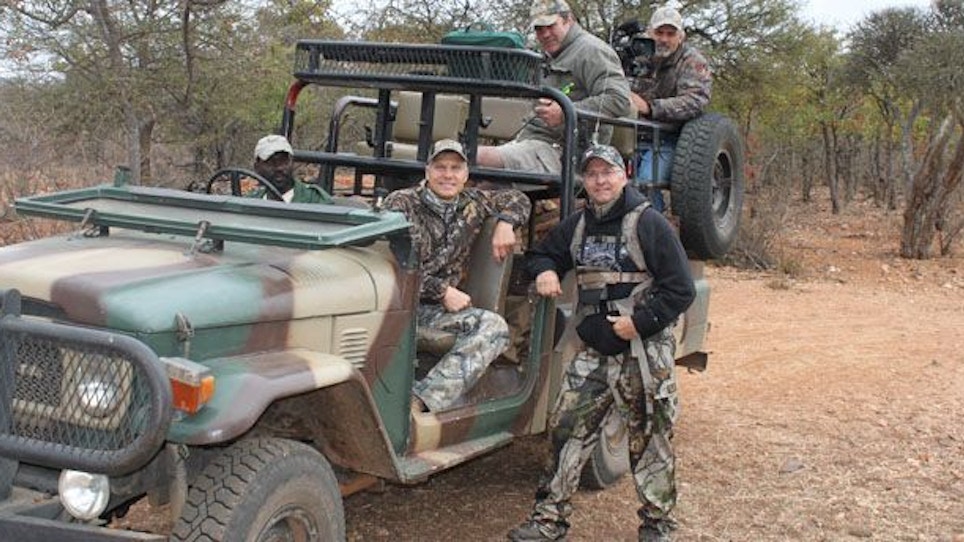Like many hunters, I have dreamed of any African safari for many years. When I finally decided to take the plunge and go, I was surprised at just how much planning was involved — it took nearly a year to plan the trip. A worthwhile labor of love, no doubt, but a long process nonetheless. If you’re thinking about going, there are a few things you should know.
I had the benefit of being invited to Africa by a friend who has traveled there numerous times. Our host was well-known outdoor writer, TV personality and author Dick Scorzafava (www.radicalbowhunter.com). Dick made some recommendations based on his experience, one of which was that we should consider using Jurie Meyer Safaris as our outfitter (www.juriemeyersafaris.co.za). I had previously had the pleasure to hunt with Jurie on a Manitoba bear hunt a year ago and was impressed with how he described his setup and hunt philosophy.
Tip: If this is your first trip to Africa, travel with someone that has been there before, if you can. Dick is a gracious host and his knowledge is extensive; this helped to diminish much of my planning anxiety. Needless to say, one of the biggest decisions you’ll make is which outfitter to use. Jurie Meyer Safaris was our outfitter and he did not disappoint! Choose your outfitter early in the planning process so you can concentrate on other details as you approach your departure date. As it turns out, planning a trip to Africa is really no more work than planning an out-of-state elk or whitetail hunt — it can be done and you will succeed.
Check out the rest of Part 1 by clicking on the pages below.
As a convenience and to best help United States clients, Jurie Meyer has asked Dick Scorzafava to be his U.S. representative and to answer questions related to hunting with Jurie. Dick lives on the East Coast. He can be contacted at (413) 568-5604 or at scorzafava@aol.com. Jurie will be attending the Safari Club International show in Reno, Jan. 26-29 and the Eastern Sports & Outdoor Show in Harrisburg, Pa. on Feb. 5-13.
Day One — Arrival in Africa
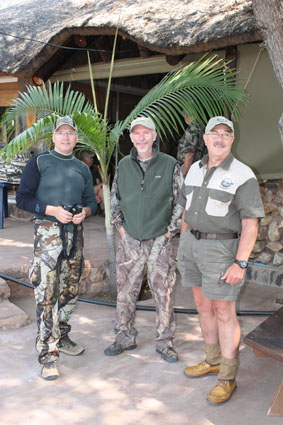 I arrived at the Minneapolis airport with bags in hand ready to embark on a 13-day hunt safari. I was bound for the Alldays district in the Limpopo region of northeastern South Africa; a trip that I had thought about since I was 12 years old. I said goodbye to my wife and kids and walked into the terminal feeling anxious (typical for me) about the check-in process at Delta airlines. I worried about having too many bags, the possibility that the bags are overweight or that my bow case will be refused. But all went smoothly and without incident — as it should have, since I had researched the number of bags and weight limitations and further weighed all my gear in advance, and I knew that my bow was packed properly. Of course now I began worry that my bags wouldn’t arrive in Johannesburg.
I arrived at the Minneapolis airport with bags in hand ready to embark on a 13-day hunt safari. I was bound for the Alldays district in the Limpopo region of northeastern South Africa; a trip that I had thought about since I was 12 years old. I said goodbye to my wife and kids and walked into the terminal feeling anxious (typical for me) about the check-in process at Delta airlines. I worried about having too many bags, the possibility that the bags are overweight or that my bow case will be refused. But all went smoothly and without incident — as it should have, since I had researched the number of bags and weight limitations and further weighed all my gear in advance, and I knew that my bow was packed properly. Of course now I began worry that my bags wouldn’t arrive in Johannesburg.
I boarded the flight to Atlanta with my traveling companion Walt Larsen of Scales Advertising. Walt represents Tight Spot Quiver, Montana Black Gold Sights, Ripcord Arrow Rests and Cuddeback trail cameras. In Atlanta, we hooked up with our buddy Ken Byers, owner of Byers Media and member of our sales team at Grand View Outdoors. Together we made our connecting 15 ½-hour flight to Johannesburg without incident. Here’s a tip: If you’re boarding a 15 ½-hour flight, bring a good book.
With some anxiety we worked our way through customs, fretting about whether or not our bags and bows had arrived safely. We immediately found Walt’s gear and bow. Ken and I found our gear bags, but our bows were nowhere in sight. Thank goodness that Jurie, our outfitter, had insisted on meeting us in the security area. Jurie was very familiar with the airport process and ultimately helped locate our bows, which had ended up in a different part of the terminal. It took about an hour to get it all sorted out, but all was now good.
We ventured to Jurie’s home in Pietersburg, where we had dinner with his family before continuing on our way to the ranch. In South Africa the driver of the vehicle sits on the right side of the car and they drive in the left lane. The confused feeling of driving on the wrong side of the road is not so bad on the highway, but in town when making turns in traffic, it gets pretty weird.
Tip: Have your outfitter meet you at the airport and drive you to the ranch. Not only was Jurie familiar with the airport process as mentioned above, but we also discovered that it was important to ensure our safety and security.
We arrived at the ranch at about 12:30 a.m., excited but exhausted from almost 32 straight hours of travel. Jurie showed us around a bit and then took us to our rooms — beautiful, newly built suites that rivaled a five-star hotel room. Jurie told us to sleep late in the morning and that he would wake us around 8. I unpacked, organized my gear and laid everything out for the morning.
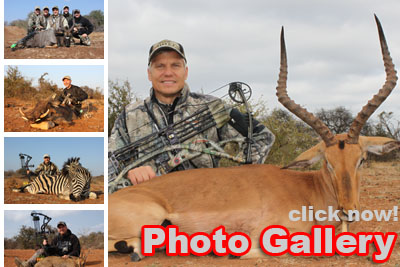 |
 |
Check out the rest of Part 1 by clicking on the pages below.
As a convenience and to best help United States clients, Jurie Meyer has asked Dick Scorzafava to be his U.S. representative and to answer questions related to hunting with Jurie. Dick lives on the East Coast. He can be contacted at (413) 568-5604 or at scorzafava@aol.com. Jurie will be attending the Safari Club International show in Reno, Jan. 26-29 and the Eastern Sports & Outdoor Show in Harrisburg, Pa. on Feb. 5-13.
Day Two — Hunting The Mamba Pit
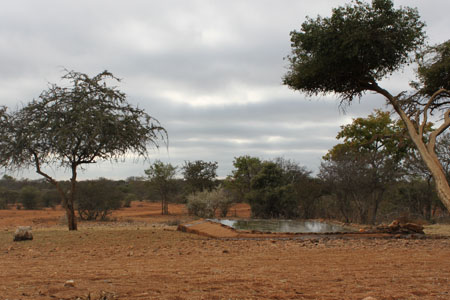 I slept pretty well that first night, despite the jetlag. But rather than sleeping until 8, I was up with the blaze-orange sun at 6. Still feeding in the dim morning light not 70 yards from my window was a herd of blesbok and a duiker; a pretty cool start to my safari. After a hearty breakfast served in the open-air dining area, we loaded into the Toyota Land Cruiser in typical safari fashion and toured a portion of the hunting grounds, passing a family group of giraffes and a herd of impala, zebra and kudu. Not bad for the first hour!
I slept pretty well that first night, despite the jetlag. But rather than sleeping until 8, I was up with the blaze-orange sun at 6. Still feeding in the dim morning light not 70 yards from my window was a herd of blesbok and a duiker; a pretty cool start to my safari. After a hearty breakfast served in the open-air dining area, we loaded into the Toyota Land Cruiser in typical safari fashion and toured a portion of the hunting grounds, passing a family group of giraffes and a herd of impala, zebra and kudu. Not bad for the first hour!
My first evening in the mamba pit blind (named for the black mamba snake, an occasional visitor) was spectacular. The pit blind is dug into the ground some 5 feet. The weird part about it is that from the in-ground vantage point I felt like I was shooting up at the animals.
My African safari was unfolding as I had dreamed about so many times! In fact, at one point during the evening I was looking simultaneously at seven giraffes, a zebra, numerous monkeys, half a dozen eland and several warthogs. I passed on a tempting 28-yard broadside shot at a zebra — only because it had been earlier decreed by my wife and daughter that I would 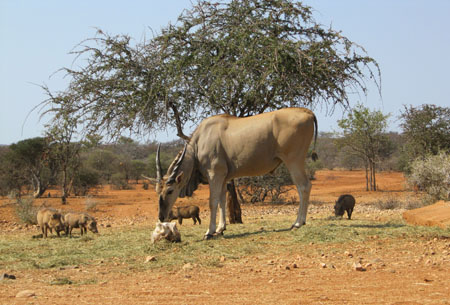 not shoot a zebra on this hunt (more on that later). We also passed on what was wrongly determined to be a non-shooter warthog. Turns out it was bigger than the one I eventually shot — oh well.
not shoot a zebra on this hunt (more on that later). We also passed on what was wrongly determined to be a non-shooter warthog. Turns out it was bigger than the one I eventually shot — oh well.
A Typical Day: As became the routine, Harry woke us each morning at 5. After eating something light we’d load into the Land Cruisers and head for the blind around 6. Typically we’d hunt until 9:30 or so and then return to camp for a big breakfast. With appetites satisfied, we’d return to the blind by noon and hunt until dark, around 6 p.m. We hunted hard and spent long hours in the blind each day. On days that game was actively moving, we’d see something most every hour and the time passed quickly. On days that it was slow, a good book was essential to pass the time. Some of the guys took turns sleeping while the other guys watched for game. Pete (my PH) and I chose to hunt the entire time.
Tip: The guys that slept in the blind soon discovered they had trouble sleeping at night!
 |
 |
Check out the rest of Part 1 by clicking on the pages below.
As a convenience and to best help United States clients, Jurie Meyer has asked Dick Scorzafava to be his U.S. representative and to answer questions related to hunting with Jurie. Dick lives on the East Coast. He can be contacted at (413) 568-5604 or at scorzafava@aol.com. Jurie will be attending the Safari Club International show in Reno, Jan. 26-29 and the Eastern Sports & Outdoor Show in Harrisburg, Pa. on Feb. 5-13.
Day Three — First Kills!
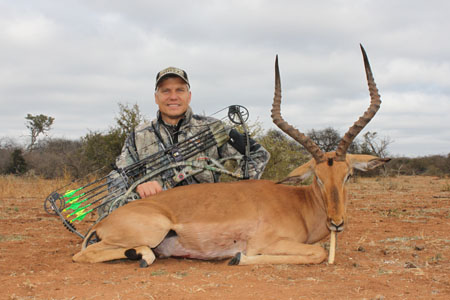 I sat in the “gravel” blind on the second morning; Ken had arrowed his warthog from this blind the night before. In terms of seeing game, it was slow compared to my hunt the evening before. We saw only a large flock of 60 guinea foul and a female duiker. Later, we heard over the radio that Ken had scored again. He and his PH had just picked up a blood trail when we arrived at his blind, and a short distance away we found the dead duiker Ken had shot. We were doing high-fives and admiring the animal when Ken told us he had also shot an impala. After another very short track job we found the beautiful, mature ram impala. Ken was on a roll — three animals down before Walt and I had drawn our bows.
I sat in the “gravel” blind on the second morning; Ken had arrowed his warthog from this blind the night before. In terms of seeing game, it was slow compared to my hunt the evening before. We saw only a large flock of 60 guinea foul and a female duiker. Later, we heard over the radio that Ken had scored again. He and his PH had just picked up a blood trail when we arrived at his blind, and a short distance away we found the dead duiker Ken had shot. We were doing high-fives and admiring the animal when Ken told us he had also shot an impala. After another very short track job we found the beautiful, mature ram impala. Ken was on a roll — three animals down before Walt and I had drawn our bows.
After lunch we headed to the baobab (pronounced bow-bob) blind. The name came from the tree that it’s built in, a baobab tree, which resembled a set from the movie “Avatar” or the home of the Swiss Family Robinson. The blind was built into the tree about 20 feet off the ground, positioned with a 14-yard shot to the water. The baobab blind complete with its two resident storks became one of my favorite places to hunt.
Soon after we arrived that afternoon, several warthogs came to the waterhole for a drink. Talk about nasty lookin’ critters! Pete gave me the nod to shoot. With confidence I placed my 20-yard pin on the shoulder of the biggest pig and released the arrow. He ran with crazy power and speed, then spun in circles, raised up on his hind legs, spun again and fell over dead. I was on the board! Pete called the trackers to come and get the hog — we never got out of the blind.
Seemingly no matter how often I patrolled the parameter (looked out the windows), game would sneak in on us. This was the case with the impala rams. It was a textbook encounter that took about 20 minutes from the time I saw them to the time the biggest ram was broadside at the waterhole. My 15-yard shot was true and the ram crashed through the water and into the same thick cover the warthog had run through two hours before. Again, Pete called the tracker. This time we got down from the tree and followed impala tracks 120 yards to where he lay dead.
Hunting Notes: Ostrich, giraffe, warthog and eland are the most frequent visitors to our blind each day. The temperature is unusually cool, making otherwise predictable waterholes suddenly unpredictable. We’re also fighting the effects of the full moon phase, which is causing the larger animals to feed at night. The animals reproduce naturally on Jurie’s concessions — it’s not a controlled game-farm operation where they replenish animals based on the kill. These animals are wild. Any thoughts that hunting Africa would be like a slam-dunk zoo shoot soon left our mind.
 |
 |
Check out Part 2 by clicking HERE.
As a convenience and to best help United States clients, Jurie Meyer has asked Dick Scorzafava to be his U.S. representative and to answer questions related to hunting with Jurie. Dick lives on the East Coast. He can be contacted at (413) 568-5604 or at scorzafava@aol.com. Jurie will be attending the Safari Club International show in Reno, Jan. 26-29 and the Eastern Sports & Outdoor Show in Harrisburg, Pa. on Feb. 5-13.
